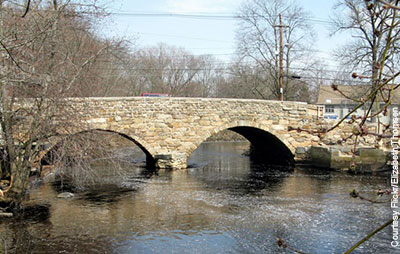Choate Bridge
42 40 46.2 N, 70 50 13.7 W

The Choate Bridge is the oldest documented two-span masonry arch bridge in the United States.
The Choate Bridge of Essex County, completed in 1764, is the oldest documented two-span masonry arch bridge in the United States. Named after Colonel John Choate, who supervised the construction, the bridge is located on South Main Street and spans the Ipswich River. Originally, the bridge measured 80 feet 6 inches long and 20 feet 6 inches wide. In 1838 it was widened to 35 feet 6 inches on the east side in order to accommodate another lane of traffic. The west side and the parapet of the bridge, along with the inscription to Colonel Choate, remained unchanged.
Since 1641, there had been a bridge at this location over the Ipswich River. These earlier bridges were constructed using timber. The longevity was not great and they needed repair or replacement over time. When, in 1764, the volume of traffic over the country road serviced by the bridge had become so great that another, wider replacement was needed, the town appointed a committee, including Colonel Choate, and charged it with "considering the bridge affair and making a report to the members." The committee determined that the existing wooden bridge needed to be replaced and recommended that a masonry bridge be built.
Composed of two elliptical arches, each of 30-foot spans at the spring line and with an approximate 9 inch rise between the spring line and crown, the original 1764 bridge was constructed of random-coursed granite ashlar blocks. The 1838 addition was made of similar construction. It provides a unique comparison of eighteenth and nineteenth century bridge technology, such as the difference in stone sizes due to the development of stone-cutting techniques.
The Choate Bridge has served as a major transportation route since its original construction in 1764. Although there have been periodic repairs, it survives basically unaltered since the 1838 widening.
The bridge is certified as a Massachusetts historic landmark and was added to the National Register of Historic Places in 1972 for its State significance in engineering and transportation.

